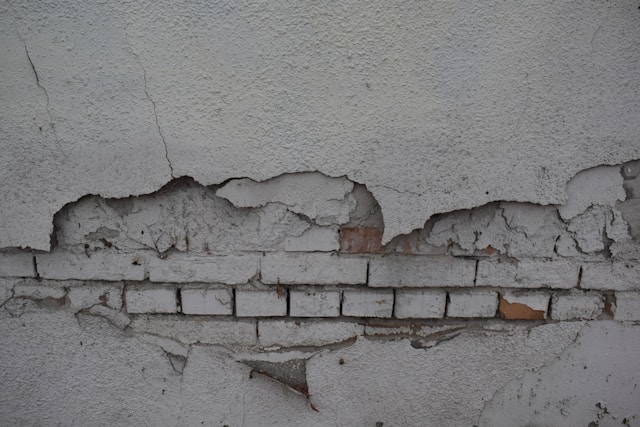A Step-by-Step Breakdown of Patriot’s Stucco Installation Process for Florida’s Climate Zone 2A
Stucco: a classic choice for exteriors, but keeping it beautiful takes know-how. This blog is your guide to maintaining, repairing, and loving your stucco home!
To guarantee a durable stucco installation in Florida’s Climate Zone 2A, you start by preparing the substrate for moisture defense, which involves applying a weather-resistant barrier (WRB) and installing flashing to protect against water intrusion. Next, you install a code-compliant lathing system, securing the metal lath to the framing members with the appropriate fasteners and guaranteeing proper lapping and penetration. Finally, you build the stucco layers, applying the scratch, brown, and finish coats with precise cure times, and conclude with post-installation checks to verify code compliance and long-term durability.

Preparing the Substrate for Moisture Defense
When preparing the substrate for moisture defense, you need to apply a Water-Resistive Barrier (WRB) that overlaps all seams by at least 6 inches and guarantees no gaps around windows and doors. Next, install flashing products, such as self-adhered flashing or metal flashing, to direct water away from the sheathing, making sure to follow the manufacturer’s instructions for proper integration with the WRB. Finally, conduct thorough inspections to verify that the WRB and flashing are correctly installed to protect the sheathing before applying the stucco.
WRB application, flashing, and inspections to protect sheathing before stucco is applied
In Florida’s Climate Zone 2A, protecting the sheathing before applying stucco is essential for preventing moisture damage. Here’s how Patriot Stucco Repair guarantees your home is protected:
- WRB Installation: Apply two layers of water-resistive barrier (WRB) directly to the wood-based sheathing.
- Flashing: Install flashing around openings and at the base of the wall to direct water away from the substrate.
- Substrate Inspection: Conduct thorough inspections to guarantee the sheathing is dry and free of defects.
- Drainage Plane: Create a drainage plane with a ventilated air space to manage moisture effectively.
Installing a Code-Compliant Lathing System
When installing a code-compliant lathing system for stucco in Florida’s Climate Zone 2A, you need to use galvanized lath to guarantee durability and compatibility with the stucco. Incorporate drainage spacers to facilitate water management and prevent moisture accumulation behind the stucco. Additionally, include expansion joints to mitigate structural stress and prevent cracking, adhering to standards such as ASTM C1063 and the Florida Building Code.
Galvanized lath, drainage spacers, and expansion joints for structure and stress mitigation
To guarantee the structural integrity and durability of stucco installations in Florida’s Climate Zone 2A, Patriot Stucco Repair employs a meticulous approach to installing galvanized lath, drainage spacers, and expansion joints.
Here are the key components:
- Galvanized metal lath: Provides strength and resistance to corrosion.
- Expansion joints in stucco: Mitigate stress from thermal expansion.
- Weep screeds: facilitate moisture drainage and prevent water intrusion.
- Moisture barrier and elastomeric stucco coating: Enhance protection against moisture and cracking.
Building the Stucco Layers: Scratch, Brown, and Finish Coats
When building the stucco layers in Florida’s Climate Zone 2A, you need to follow a specific sequence to guarantee durability. Start with the scratch coat, a rough layer that helps the subsequent layers adhere, then apply the brown coat to add strength and even out the surface. Each layer must be allowed to cure for the appropriate time, typically 24 to 48 hours for initial drying and a minimum of 28 days for complete curing, to prevent cracking and moisture issues.
Application sequence, cure times, and surface smoothing tailored to Zone 2A’s climate
In Florida’s Climate Zone 2A, Patriot Stucco’s installation process begins with the application of the scratch coat, a critical initial layer that sets the foundation for the entire stucco system. Here’s how they tailor the application sequence, cure times, and surface smoothing:
- Scratch Coat: Applied to the metal lath, guaranteeing strong adhesion.
- Brown Coat: Applied after the scratch coat has cured, providing a smooth surface.
- Finish Coat: The final layer, applied with UV-resistant coatings for durability.
- Cure Times: Strict adherence to manufacturer guidelines to guarantee proper curing in hot-humid conditions.
This process guarantees your stucco system is resilient and long-lasting.
Post-Installation Checks and Long-Term Client Value
After completing the stucco installation, you need to make certain that the job is done correctly and meets all the necessary standards. Patriot Stucco Repair conducts thorough post-installation testing to verify the integrity of the stucco layers and checks all sealants to prevent moisture intrusion and cracks. This process is finalized with detailed compliance documentation to guarantee that the work adheres to local building codes and provides long-term durability and client satisfaction.
Testing, sealant checks, and compliance documentation to ensure a durable, finished result
To guarantee a durable and long-lasting stucco installation, Patriot Stucco Repair’s process includes meticulous post-installation testing, thorough sealant checks, and rigorous compliance documentation.
Here are the key steps they follow:
- Compliance with ASTM C926: Confirming the stucco installation meets industry standards.
- Moisture Barrier Verification: Checking the integrity of Tyvek WRB or Blueskin moisture barrier.
- Sealant Integrity: Verifying seals around windows, doors, and vents to prevent water intrusion.
- UV Resistance Testing: Confirming the effectiveness of UV-resistant coatings and elastomeric finishes.
This guarantees your stucco installation in Central Florida withstands the climate.
Call to speak with one of our professional stucco contractors | 610-590-9285
Patriot Stucco Repair
We can help you repair and remodel your home exterior! Call us today and learn how Patriot Stucco Repair can help.
The region's leading professional stucco contractor
Proudly powered by Snapps website builder



